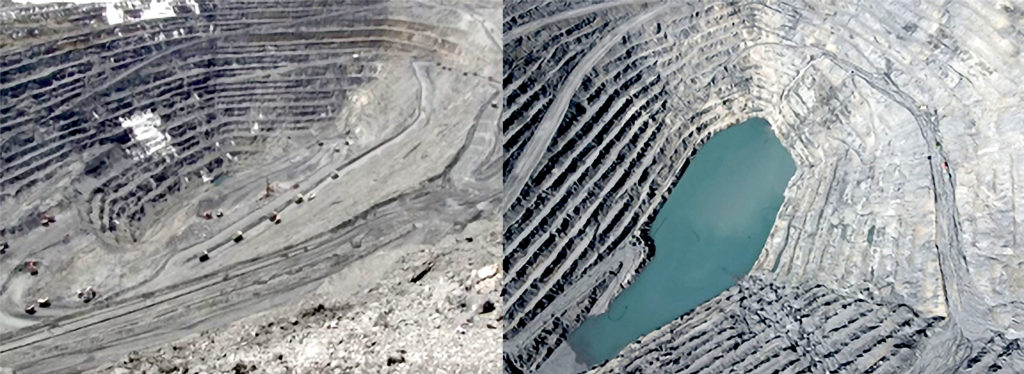Centerra says 40 metres of water at Kumtor pit a threat to workers, environment
While the government-controlled Kumtor Gold Company (KGC) said the mine is stable and running at full speed, Centerra said it has photographic evidence suggesting the contrary. They include a video posted on August 15 on KGC’s Facebook page.

“Based on these images, Centerra believes at least 40 meters of water may be at the bottom of the Kumtor central pit (…) This has put the entire mine and its workers at risk of potentially catastrophic events, not to mention the real harm to the environment.,” the company said in an emailed statement.
The miner believes urgent action is needed to address critical safety and operational issues.
“This is massive and the entire situation presents an imminent danger at many levels, not just the water in the pit, but also the tailings storage facility due to glacier melt”, Lindsay Newland Bowker, executive director of World Mine Tailings Failures told MINING.COM.
“The Kyrgyz government has zero capacity and no money to take on a proper assessment or correction of this problem,” she added.
The mine pit slices through two glaciers — Lysyi and Davidov. This vicinity and the practice of storing waste rock directly on the glaciers represents a risk to the enormous natural ice sheets, according to data compiled by Bankwacht Network
Water is a danger in pits in several ways, including affecting slope stability and a potential leak of the metal-rich water stored there, known as mine drainage, says Geoff Beale from Piteau Associates, a Canadian geotechnical and water management consultancy.
“Water is a danger in pits in several ways, including slope stability and a potential leak of the metal-rich water store there, known as mine drainage”
GeofF Beale, Piteau Associates
In an online seminar last year, Beale — who is also co-editor of the CSIRO Guidelines for Evaluating Water in Pit Slope Stability — noted the amount of water contained in a pit can be an accident catalyzer.
“Water changes the resistive forces of a slope and creates driving forces. It’s a very simple concept. It’s two forces acting at the same time— the downward pressure of the rocks that holds the material together and the other is the upper pressure of the water that can break the rock. The less water, the more resistance,” he said.
One of the most well-known of landslide in an open pit is the one that happened at Rio Tinto’s Bingham Canyon copper mine in Utah in 2013. The incident did not claim victims, but it damaged equipment, a building structure, slowed output, and took at least three years to repair.
Resource nationalism
The Kyrgyz’s parliament passed in early May a law allowing the state to temporarily take over Kumtor gold mine, the country’s biggest industrial enterprise.
Kyrgyzstan’s move came after a court fined Centerra’s unit Kumtor Gold Company (KGC) more than $3 billion for allegedly dumping mining waste on glaciers near the mine 4,000 meters above sea level. A state commission also recently alleged that KGC owed more than $1 billion in unpaid taxes.
Kumtor is the largest of Centerra’s three gold mines, accounting for over 50% of the company’s total output. Since the seizure, Centerra’s Kyrgyz subsidiaries have filed for Chapter 11 bankruptcy protection. The company has also sued the new external manager of the mine, alleging that he conspired to steal the asset while he was a director.
Centerra said at the time that KGC and the Kumtor Operating Company CJSC (KOC) were solvent, with total assets (including the Kumtor mine) above $1.1 billion and no external bank debt.
Kumtor Gold Company’s video:
The Canadian miner is not a party to or affected by the Chapter 11 filing and remains with more than $883 million in cash and almost $1.3 billion in liquidity as of June 30, 2021, it said earlier this month.
The mine has produced more than 13.2 million ounces of gold between 1997 and the end of 2020. Last year’s output was slightly over 556,000 ounces. Centerra guided in January for Kumtor to produce 470,000 to 510,000 ounces of gold, with improving grades and production expected towards year-end.
The operation is considered by analysts a classic example of the risks tied to resource nationalism, as it has been for years the subject of both renegotiations protracted legal battles.
Centerra is currently seeking to hold the Kyrgyz government and Kyrgyzaltyn responsible for all losses and damages that result from their coordinated campaign to seize the gold mine in violation of longstanding investment agreements and without compensation to Centerra.
The company also seeks to prevent the Kyrgyz government and Kyrgyzaltyn from taking any further actions to nationalize the mine or improperly dispose of it.
Its two units, KGC and KOC, filed last week a motion in a US Bankruptcy Court seeking penalties of $1 million a day against the Kyrgyzstan government.
Kyrgyz authorities have not yet replied to MINING.COM’s request for comments on Centerra’s statement.




